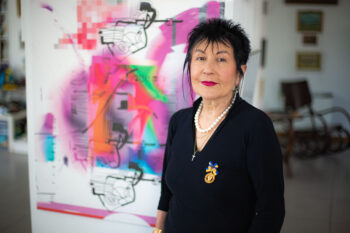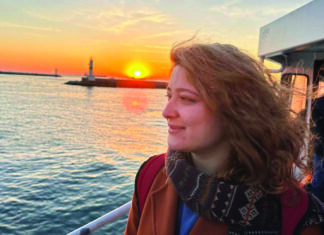Dawn Anahid MacKeen is an award-winning author of The Hundred-Year Walk: An Armenian Odyssey, which chronicles the harrowing story of her beloved and courageous grandfather Stepan Miskjian, who survived the ravages of the 1915 Armenian Genocide thanks to the “kindness of a Muslim sheikh and his family.”
Dawn’s book is required reading in many high schools and at the university level throughout the United States, and was a finalist for the Dayton Literary Peace Prize. In her book, MacKeen uses her grandfather Stepan’s detailed journals to write about his crossing the desert into Syria on foot and going far into the interior, all with an astonishingly small amount of food and water. She then wrote about her own retracing of those steps in 2007.

Stepan, a survivor of the Armenian Genocide, recorded details of this life-altering experience and his escape to freedom in his journals which he kept throughout his life. Those journals were passed down to Dawn’s mother who tucked them away, out of sight for decades. In the mid-2000’s, on a trip home to California to visit her parents, Dawn finds the handwritten books and suddenly becomes consumed by stories surrounding her grandfather’s daring and heroic escape. Filled with a desire to understand her own family history and the struggles Stepan faced, Dawn begins piecing together his cataclysmic journey as he walked through cities, over mountains, and eventually across the desert in order to escape death. Retelling Stepan’s story as events unfolded in 1915, Dawn also parallels this ancient history with her own modern day journey of exploration in the 2000’s, as she follows in his own footsteps retracing his route through modern day Turkey and Syria – a young woman traveling alone amid post 9/11 tension and unease.

Their shared story is a testament to family, to home, and to the power of the human spirit to transcend the barriers of religion, ethnicity, and even time itself.
“Ever since I could remember, I had heard these dramatic tales from my mother: how my grandfather wandered for years in the desert of what is now Syria; how he, Stepan Miskjian, staggered a week with two cups of water, trying to escape from the Turks who were trying to kill him, for the crime of being an Armenian,” she says. “He had been drafted into a labor battalion in 1915. He eventually ended up in what’s now Syria, where some of the locals saved him.” Dawn traced his steps from Adabazar (Adapazari) in Turkey to the deportation routes in Syria.
“I have been grateful that my grandfather’s courageous story continues to reach a wider audience. He believed he had survived the Armenian Genocide in order to bear witness.” What Dawn found in writing the book and in its aftermath is more than she ever imagined when she began the decade-long research into her grandfather’s story. “I’ve been continually moved by the response to the book,” she says. “Many non-Armenian readers have written to tell me how they had considered themselves knowledgeable about history, but didn’t know about what had happened to the Armenians or their history. They learned about it through my grandfather’s survival story, all detailed in his recently discovered journals.”









